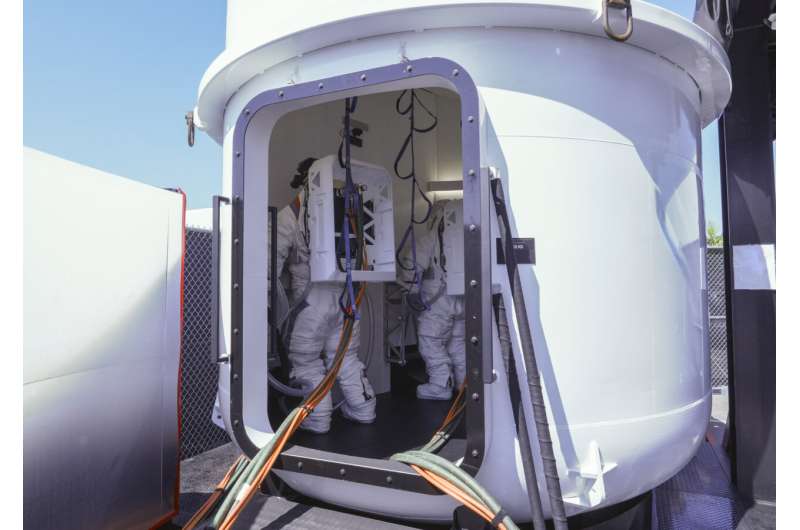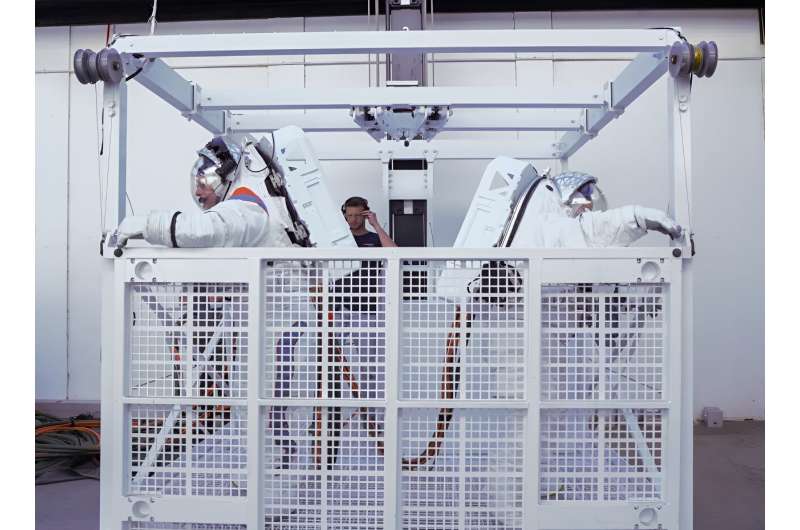Astronauts were fully suited while conducting mission-like maneuvers in the full-scale build of the Starship human landing system’s airlock which will be located inside Starship under the crew cabin. Credit: SpaceX
The physics remain the same, but the rockets, spacecraft, landers, and spacesuits are new as NASA and its industry partners prepare for Artemis astronauts to walk on the moon for the first time since 1972.
NASA astronaut Doug "Wheels" Wheelock and Axiom Space astronaut Peggy Whitson put on spacesuits, developed by Axiom Space, to interact with and evaluate full-scale developmental hardware of SpaceX's Starship HLS (Human Landing System) that will be used for landing humans on the moon under Artemis. The test, conducted April 30, marked the first time astronauts in pressurized spacesuits interacted with a test version of Starship HLS hardware.
"With Artemis, NASA is going to the moon in a whole new way, with international partners and industry partners like Axiom Space and SpaceX. These partners are contributing their expertise and providing integral parts of the deep space architecture that they develop with NASA's insight and oversight," said Amit Kshatriya, NASA's Moon to Mars program manager.
"Integrated tests like this one, with key programs and partners working together, are crucial to ensure systems operate smoothly and are safe and effective for astronauts before they take the next steps on the moon."
The day-long test, conducted at SpaceX headquarters in Hawthorne, California, provided NASA and its partners with valuable feedback on the layout, physical design, mechanical assemblies, and clearances inside the Starship HLS, as well as the flexibility and agility of the suits, known as the AxEMU (Axiom Extravehicular Mobility Unit).
To begin the test, Wheelock and Whitson put on the spacesuits in the full-scale airlock that sits on Starship's airlock deck. Suits were then pressurized using a system immediately outside the HLS airlock that provided air, electrical power, cooling, and communications to the astronauts. Each AxEMU also included a full-scale model of the Portable Life Support System, or "backpack," on the back of the suits.
For Artemis moonwalks, each crew member will put on a spacesuit with minimal assistance, so the team was eager to evaluate how easily the suits can be put on, taken off, and stowed in the airlock.
During the test, NASA and SpaceX engineers were also able to evaluate placement of mobility aids, such as handrails, for traversing the hatch. Another set of mobility aids, straps hanging from the ceiling in the airlock, assisted the astronauts when entering and removing the AxEMU suits. The astronauts also practiced interacting with a control panel in the airlock, ensuring controls could be reached and activated while the astronauts were wearing gloves.
Wheelock and Whitson were able to test the agility of the spacesuits by conducting movements and tasks similar to those necessary during lunar surface exploration on Artemis missions, such as operating Starship's elevator gate. Credit: SpaceX
"Overall, I was pleased with the astronauts' operation of the control panel and with their ability to perform the difficult tasks they will have to do before stepping onto the moon," said Logan Kennedy, lead for surface activities in NASA's HLS Program. "The test also confirmed that the amount of space available in the airlock, on the deck, and in the elevator, are sufficient for the work our astronauts plan to do."
The suited astronauts also walked the from Starship's airlock deck to the elevator built for testing. During Artemis missions, the elevator will take NASA astronauts and their equipment from the deck to the lunar surface for a moonwalk and then back again. Whitson and Wheelock practiced opening a gate to enter the elevator while evaluating the dexterity of the AxEMU suit gloves, and practiced lowering the ramp that astronauts will use to take the next steps on the moon.
The steps the astronauts took in the spacesuits through full-scale builds of the Starship hatch, airlock, airlock deck, and elevator may have been small, but they marked an important step toward preparing for a new generation of moonwalks as part of Artemis.
For the Artemis III mission, SpaceX will provide the Starship HLS that will dock with Orion in lunar orbit and take two astronauts to and from the surface of the moon. Axiom Space is providing a new generation of spacesuits for moonwalks that are designed to fit a wider range of astronauts.
With Artemis, NASA will explore more of the moon than ever before, learn how to live and work away from home, and prepare for future human exploration of the red planet. NASA's SLS (Space Launch System) rocket, exploration ground systems, and Orion spacecraft, along with the human landing system, next-generation spacesuits, Gateway lunar space station, and future rovers are NASA's foundation for deep space exploration.
Provided by NASA

























